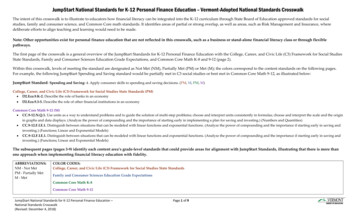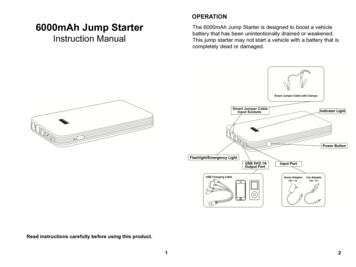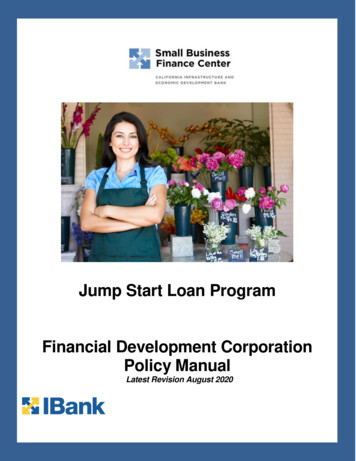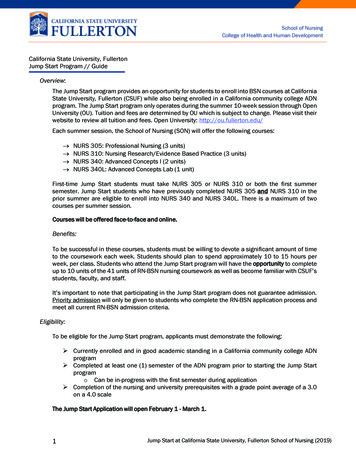
Transcription
Jump tart National Standards for K-12 Personal Finance Education – Vermont-Adopted National Standards CrosswalkThe intent of this crosswalk is to illustrate to educators how financial literacy can be integrated into the K-12 curriculum through State Board of Education approved standards for socialstudies, family and consumer science, and Common Core math standards. It identifies areas of partial or strong overlap, as well as areas, such as Risk Management and Insurance, wheredeliberate efforts to align teaching and learning would need to be made.Note: Other opportunities exist for personal finance education that are not reflected in this crosswalk, such as a business or stand-alone financial literacy class or through flexiblepathways.The first page of the crosswalk is a general overview of the Jump tart Standards for K-12 Personal Finance Education with the College, Career, and Civic Life (C3) Framework for Social StudiesState Standards, Family and Consumer Sciences Education Grade Expectations, and Common Core Math K-8 and 9-12 (page 2).Within this crosswalk, levels of meeting the standard are designated as Not Met (NM), Partially Met (PM) or Met (M); the colors correspond to the content standards on the following pages.For example, the following Jump tart Spending and Saving standard would be partially met in C3 social studies or best met in Common Core Math 9-12, as illustrated below:Jump tart Standard: Spending and Saving- 4. Apply consumer skills to spending and saving decisions. (PM, M, PM, M)College, Career, and Civic Life (C3) Framework for Social Studies State Standards (PM) D2.Eco.9.K-2. Describe the role of banks in an economy D2.Eco.9.3-5. Describe the role of other financial institutions in an economyCommon Core Math 9-12 (M) CC.9-12.N.Q.1. Use units as a way to understand problems and to guide the solution of multi-step problems; choose and interpret units consistently in formulas; choose and interpret the scale and the originin graphs and data displays. (Analyze the power of compounding and the importance of starting early in implementing a plan for saving and investing.) (Numbers and Quantities) CC.9-12.F.LE.1. Distinguish between situations that can be modeled with linear functions and exponential functions. (Analyze the power of compounding and the importance if starting early in saving andinvesting.) (Functions; Linear and Exponential Models) CC.9-12.F.LE.1. Distinguish between situations that can be modeled with linear functions and exponential functions. (Analyze the power of compounding and the importance if starting early in saving andinvesting.) (Functions; Linear and Exponential Models)The subsequent pages (pages 3-9) identify each content area’s grade-level standards that could provide areas for alignment with Jump tart Standards, illustrating that there is more thanone approach when implementing financial literacy education with fidelity.ABBREVIATIONS:NM - Not MetPM - Partially MetM - MetCOLOR CODES:College, Career, and Civic Life (C3) Framework for Social Studies State StandardsFamily and Consumer Sciences Education Grade ExpectationsCommon Core Math K-8Common Core Math 9-12Jump tart National Standards for K-12 Personal Finance Education –National Standards Crosswalk(Revised: December 4, 2018)Page 1 of 9
Jump tartStandardsKnowledgestatementssupporting eachof the sixJump tartstandards.Spending and SavingApply strategies to monitorincome and expenses, planfor spending and save forfuture goals.1. Develop a plan forspending and saving (PM,M, NM, M)2. Develop a system forkeeping and usingfinancial records. (NM,NM, NM, PM)3. Describe how to usedifferent paymentmethods. (PM, NM, PM,PM)4. Apply consumer skills tospending and savingdecisions. (PM, M, PM, M)Credit and Debt- Developand manage strategies tocontrol and manage creditand debt.Employment and IncomeUse a career plan to developpersonal income potential.Investing- Implement adiversified investmentstrategy that is compatiblewith personal financial goals.1. Analyze the costs andbenefits of various typesof credit. (PM, NM, PM,M)2. Summarize the borrower’srights and responsibilitiesrelated to credit reports.(NM, NM, NM, NM)3. Apply strategies to avoidor correct debtmanagement problems.(NM, NM, NM, NM)4. Summarize majorconsumer credit laws.(PM, NM, NM, NM)1. Explore job and careeroptions. (NM, M, NM,NM)2. Compare sources ofpersonal income andcompensation. (PM, M,NM, M)3. Analyze factors that affectnet income. (PM, PM, PM,M)1. Explain how investingmay build wealth and helpmeet financial goals. (PM,NM, PM, PM)2. Evaluate investmentalternatives. (PM, NM,PM, PM)3. Demonstrate how to buyand sell investments. (NM,NM, NM, PM)4. Investigate how agenciesprotect investors andregulate financial marketsand products. (NM, NM,NM, NM)General overview ofthe Jump tartstandards with theCollege, Career, andCivic Life (C3)Framework for SocialStudies StateStandards, Familyand ConsumerSciences EducationGrade Expectations,and Common CoreMath K-8 and 9-12.Jump tart National Standards for K-12 Personal Finance Education –National Standards Crosswalk(Revised: December 4, 2018)Page 2 of 9Risk Management andInsurance- Applyappropriate and costeffective risk managementstrategies.1. Identify common types ofrisks and basic riskmanagement methods.(NM, NM, NM, NM)2. Justify reasons to useproperty and liabilityinsurance. (NM, NM, NM,PM)3. Justify reasons to usehealth, disability, longterm care and lifeinsurance. (NM, NM, NM,PM)Financial Decision MakingApply reliable informationand systemic decisionmaking to personal financialdecisions.1. Recognize theresponsibilities associatedwith personal financialdecisions. (M, M, PM, M)2. Use reliable sources whenmaking financial decisions.(M, M, PM, PM)3. Summarize majorconsumer protection laws.(PM, M, NM, NM)4. Make criterion-basedfinancial decisions bysystematically consideringalternatives andconsequences. (M, M, M,M)5. Apply communicationstrategies when discussingfinancial issues. (PM, M,NM, NM)6. Analyze the requirementsof contractual obligations.(NM, NM, NM, NM)7. Control personalinformation. (NM, NM,NM, NM)8. Use a personal financialplan. (PM, M, PM, M)
Jump tartStandardsCollege, Careerand Civic Life(C3)Framework forSocial StudiesStandardsEco- EconomicsSpending and SavingApply strategies to monitorincome and expenses, planfor spending and save forfuture goals.D2.Eco.5.3-5. Explain therole of money in makingexchange easier.D2.Eco.9.K-2. Describe therole of banks in aneconomy.D2.Eco.9.3-5. Describe therole of other financialinstitutions in an economy.D2.Eco.10.K-2. Explain whypeople save.D2.Eco.10.3-5. Explain whatinterest rates are.Credit and Debt- Developand manage strategies tocontrol and manage creditand debt.Employment and IncomeUse a career plan to developpersonal income potential.D2.Eco.10.3-5. Explain whatinterest rates are.D2.Eco.10.6-8. Explain theinfluence of changes ininterest rates on borrowingand investing.D2.Eco.3.K-2. Describe theskills and knowledgerequired to produce certaingoods and services.D2.Eco.6.K-2. Explain howpeople earn income.D2.Eco.6.3-5. Explain therelationship betweeninvestment in humancapital, productivity, andfuture incomes.D2.Eco.12.6-8. Explain howinflation, deflation andunemployment affectdifferent groups.Within a particularJump tartstandard, these C3standards showopportunitieswhere learning canbe addressed inboth financialliteracy and socialstudies.Jump tart National Standards for K-12 Personal Finance Education –National Standards Crosswalk(Revised: December 4, 2018)Page 3 of 9Investing- Implement adiversified investmentstrategy that is compatiblewith personal financialgoals.D2.Eco.10.3-5. Explain whatinterest rates are.D2.Eco.10.6-8. Explain theinfluence of changes ininterest rates on borrowingand investingRisk Management andInsurance- Applyappropriate and costeffective risk managementstrategies.Financial Decision MakingApply reliable information andsystemic decision making topersonal financial decisions.D2.Eco.1.K-2. Explain how scarcitynecessitates decision making.D2.Eco.1.3-5. Compare the benefitsand costs of individual choices.D2.Eco.1.6-8. Explain howeconomic decisions affect the wellbeing of individuals, businessesand society.D2.Eco.1.9-12. Analyze howincentives influence choices thatmay result in policies with a rangeof costs and benefits for differentgroups.D2.Eco.2.K-2. Identify the benefitsand costs of making variouspersonal decisions.D2.Eco.2.3-5. Identify positive andnegative incentives that influencethe decisions people make.D2.Eco.2.6-8. Evaluate alternativeapproaches or solutions to currenteconomic issues in terms ofbenefits and costs to differentgroups and society as a whole.D2.Eco.2.9-12. Use marginalbenefits and marginal costs toconstruct an argument for oragainst an approach or solution toan economic issue.
Jump tartStandardsSpending and SavingApply strategies to monitorincome and expenses, planfor spending and save forfuture goals.Family andConsumerSciences (FACS)Education GradeExpectationsCFR.5-8. Distinguishingbetween personal needs andwants.CFR.5-8. Examining howindividuals and familiesmake choices to satisfyneeds and wants.CFR.5-8. Creating a plan forspending and savingresources.CFR.9-12. Designing astrategy for earning,spending and savingpersonal financial resources.CFR- Consumerand FamilyResourcesCCFC- Career,Community andFamilyConnectionsCredit and DebtDevelop andmanage strategies tocontrol and managecredit and debt.Employment and Income- Use acareer plan to develop personalincome potential.CCFC.5-8. Exploring potentialcareer choices to determineknowledge, skills and attitudeassociated with each.CCFC.9-12. Developing a life planincluding pathways to acquiringknowledge and skills needed toachieve individual, family andcareer goals.CCFC.9-12. Demonstrating jobseeking and job keeping skills.CCFC.5-8 and CCFC.9-12Practicing and applyingemployability skills such as goodcommunication, teamwork, andleadership in community andworkplace settings.Within a particularJump tartstandard, theseFACS standardsshowopportunitieswhere learning canbe addressed inboth financialliteracy and familyand consumerscience.Jump tart National Standards for K-12 Personal Finance Education –National Standards Crosswalk(Revised: December 4, 2018)Page 4 of 9InvestingImplement adiversifiedinvestmentstrategy that iscompatible withpersonal financialgoals.RiskManagement andInsurance- Applyappropriate andcost-effective riskmanagementstrategies.Financial Decision Making- Apply reliableinformation and systemic decision making topersonal financial decisions.CCFC.9-12. Analyzing the potential impact of careerpath decisions on balancing work and family.CCFC.5-8. and CCFC. 9-12 Recognizing anddemonstrating strategies to manage multiple rolesand responsibilities (individual, family, career,community).CCFC.9-12. Examining policies, issues and trends inthe workplace and community that impactindividuals and families.CFR.5-8. Exploring the interrelationship between theeconomic system and consumer action.CFR.5-8 and CFR.9-12 Demonstrating management ofindividual and family resources, including time, food,clothing, shelter, healthcare, recreation andtransportation.CFR.5-8 and CFR.9-12 Applying decision-makingskills when selecting services, food, clothing, housing,furnishings, transportation or recreational needs.CFR.5-8 and CFR.9-12 Identifying how marketingand advertisinginfluence consumption patterns.CFR.5-8 and CFR.9-12 Examining and practicingbehaviors that conserve, reuse and recycle resourcesto maintain the environment.CFR.9-12. Identifying how media and technologicaladvances impact family and consumer decisions.CFR.9-12. Determining practices that allow families tomaintain economic self-sufficiency.CFR.9-12. Identify policies that support consumerrights and responsibilities.
Jump tartStandardsSpending and Saving- Applystrategies to monitor income andexpenses, plan for spending andsave for future goals.Credit and DebtDevelop andmanage strategies tocontrol and managecredit and debt.Employment and Income- Use acareer plan to develop personalincome potential.Common Core MathK-8CC1 and 2.OA.A. Represent andsolve problems involving additionand subtraction.CC2.MD.C. Work with time andmoney.CC.2.MD.8. Solve word problemswith monetary units.CC.2.OA.C. Work with equalgroups of objects to gainfoundations for multiplication.CC.2.NBT.A. Understand placevalue.CC.2.NBT.B. Use place valueunderstanding and properties ofoperations to add and subtract.CC.5.NBT.1-4. Understand theplace value system and performoperations with multi-digit wholenumbers and with decimals to thehundredths.CC.6.NS.2. Fluently divide multidigit numbers using the standardalgorithm.CC.6.NS.3. Fluently add, subtract,multiply and divide multi-digitdecimals using the standardalgorithm for each operation.CC.7.RP.3. Use proportionalrelationships to solve multi-stepratio and percent problems.CC.7.RP.3. Useproportionalrelationships tosolve multi-stepratio and percentproblems.CC.2.MD.8. Solve word problemswith monetary units.CC.2.OA.C. Work with equalgroups of objects to gainfoundations for multiplication.CC.2.NBT.A. Understand placevalueCC.2.NBT.B. Use place valueunderstanding and properties ofoperations to add and subtract.CC.5.NBT.1-4. Understand theplace value system and performoperations with multi-digit wholenumbers and with decimals to thehundredths.CC.6.NS.2. Fluently divide multidigit numbers using the standardalgorithm.CC.6.NS.3. Fluently add, subtract,multiply and divide multi-digitdecimals using the standardalgorithm for each operation.CC.7.RP.3. Use proportionalrelationships to solve multi-stepratio and percent problems.MD- Measurement andDataNBT- Number andOperation in Base TenNS- The Number SystemOA- Operations andAlgebraic ThinkingRP- Ratios and ProportionalRelationshipsWithin a particularJump tart standard, theseCommon Core Mathstandards showopportunities wherelearning can be addressedin both financial literacyand K-8 math.Jump tart National Standards for K-12 Personal Finance Education –National Standards Crosswalk(Revised: December 4, 2018)Page 5 of 9InvestingImplement adiversifiedinvestmentstrategy that iscompatible withpersonal financialgoals.CC.7.RP.3. Useproportionalrelationships tosolve multi-stepratio and percentproblems.Risk Managementand InsuranceApply appropriateand cost-effectiverisk managementstrategies.Financial Decision Making- Applyreliable information and systemicdecision making to personal financialdecisions.CC.2.OA.C. Work with equal groups ofobjects to gain foundations formultiplication.CC.3.OA.3. Use multiplication anddivision within 100 to solve wordproblems in situations.CC.3.OA.8. Solve two-step wordproblems using letter for unknown.CC.3.MD.3. Draw scaled graph torepresent data with several categories.CC.3.NBT.A. Use place valueunderstanding and properties ofoperations to perform multi-digitarithmetic.CC.5.NBT.1-4. Understand the placevalue system and perform operationswith multi-digit whole numbers andwith decimals to the hundredths.CC.6.NS.2. Fluently divide multi-digitnumbers using the standard algorithm.CC.6.NS.3. Fluently add, subtract,multiply and divide multi-digitdecimals using the standard algorithmfor each operation.CC.7.RP.3. Use proportionalrelationships to solve multi-step ratioand percent problems.
Jump tartStandardsCommon Core Math9-12A- AlgebraSSE- Solving Systems ofEquationsCED- Creating Equationsthat DescribeREI- Reasoning withEquations and InequalitiesF- FunctionsBF- Building FunctionsIF- Interpreting FunctionsLE- Linear andExponentialModelsN- Numbers andQuantitiesQ- QuantitiesWithin a particularJump tart standard, theseCommon Core Mathstandards showopportunities wherelearning can be addressedin both financial literacyand 9-12 math.Spending and SavingApply strategies to monitorincome and expenses, planfor spending and save forfuture goals.CC.9-12.A.REI.1. Explaineach step in solvingequations as following fromthe equality of numbersasserted at the previous step,starting from the assumptionthat the original equation hasa solution. Construct a viableargument to justify asolution method. (Describesteps in a bank reconciliationprocess).CC.9-12.A.REI.2. Solvesimple rational and radicalequations in one variable,and give examples showinghow solutions may arise.(Describe and use the stepsinvolved in a bankreconciliation process.)CC.9-12.A.CED.2. Createequations in two or morevariables to representrelationships betweenquantities; graph equationson coordinate axes withlabels and scales. (Comparecosts and benefits of onlineand traditional banking.)Credit and Debt- Developand manage strategies tocontrol and manage creditand debt.Employment and IncomeUse a career plan todevelop personal incomepotential.CC.9-12.A.REI.1. Explaineach step in solving simpleequations as following fromequality of numbersasserted at the previousstep, starting from theassumption that theoriginal equation has asolution. Construct a viableargument to justify asolution method. (Calculatea payment schedule for aloan.)CC.9-12.A.REI.2. Solvesimple rational and radicalequations in one variable,and give examples showinghow extraneous solutionsmay arise. (Calculate apayment schedule for aloan.)CC.9-12.A.CED.2. Createequations in two or morevariables to representrelationships betweenquantities; graph equationson coordinate axes withlabels and scales. (Compareand contrast variousaspects of credit cards.)CC.9-12.A.SSE.1. Interpretexpressions that represent aquantity in terms of itscontext. (Calculate net pay,explain the effect on takehome pay of changingallowances and analyze theeffects of inflation onincome.)CC.9-12.A.CED.1. Createequations and inequalitiesin one variable and usethem to solve problems.(Calculate net pay, explainthe effect on take-home payof changing allowances andanalyze the effects ofinflation on income.)CC.9-12.A.CED.2. Createequations in two or morevariables to representrelationships betweenquantities; graph equationson coordinate axes withlabels and scales. (Calculatenet pay and Compare andcontrast compensationpackages that includevarying levels of wages andbenefits.)Jump tart National Standards for K-12 Personal Finance Education –National Standards Crosswalk(Revised: December 4, 2018)Page 6 of 9Investing- Implement adiversified investmentstrategy that is compatiblewith personal financialgoals.CC.9-12.F.IF.4. For afunction that models arelationship between twoquantities, interpret keyfeatures of graphs andtables in terms of thequantities, and sketchgraphs showing keyfeatures given in a verbaldescription of therelationship. (Explain howand why the stock marketworks.)CC.9-12.F.IF.5. Relate thedomain of a function to itsgraph and, whereapplicable, to thequantitative relationship itdescribes. (Explain how andwhy the stock marketworks.)CC.9-12.F.IF.6. Calculateand interpret the averagerate of change of a functionover a specified interval.Estimate the rate of changefrom a graph. (Explain howand why the stock marketworks.)Risk Management andInsurance- Applyappropriate and costeffective risk managementstrategies.CC.9-12.F.LE.5. Interpretthe parameters in a linear,quadratic or exponentialfunction in terms ofcontext. (Developrecommended insurancecoverage for individuals atdifferent income levels.)Financial Decision MakingApply reliable informationand systemic decisionmaking to personal financialdecisions.CC.9-12.A.CED.2. Createequations in two or morevariables to representrelationships betweenquantities; graph equationson coordinate axes withlabels and scales. (Comparecosts and benefits, ofpurchasing, leasing andrenting.)CC.9-12.A.CED.3. Representconstraints by equations orinequalities, and by systemsof equations and/orinequalities, and interpretsolutions as viable or nonviable options in modelingcontext. (Compare costs andbenefits of purchasing,leasing or renting.)CC.9-12.A.REI.1. Explaineach step in solving simpleequations as following fromthe equality of numbersasserted at the previous step,starting from theassumption that the originalequation has a solution.Construct a viable argumentto justify a solution method.(Calculate costs of utilities,services, maintenance andother living expenses.)
Jump tartStandardsCommon Core Math9-12 (Cont.)A- AlgebraSSE- Solving Systems ofEquationsCED- Creating Equationsthat DescribeREI- Reasoning withEquations and InequalitiesF- FunctionsBF- Building FunctionsIF- Interpreting FunctionsLE- Linear andExponentialModelsN- Numbers andQuantitiesQ- QuantitiesWithin a particularJump tart standard, theseCommon Core Mathstandards showopportunities wherelearning can be addressedin both financial literacyand 9-12 math.Spending and SavingApply strategies to monitorincome and expenses, planfor spending and save forfuture goals.CC.9-12.A.CED.3. Representconstraints by equations orinequalities, and by systemsof equations and/orinequalities, and interpretsolutions as viable or nonviable options in modelingcontext. (Compare costs andbenefits of online andtraditional banking.)CC.9-12.N.Q.1. Use units asa way to understandproblems and to guide thesolution of multi-stepproblems; choose andinterpret units consistentlyin formulas; choose andinterpret the scale and theorigin in graphs and datadisplays. (Analyze the powerof compounding and theimportance of starting earlyin implementing a plan forsaving and investing.)CC.9-12.F.LE.1. Distinguishbetween situations that canbe modeled with linearfunctions and exponentialfunctions. (Analyze thepower of compounding andthe importance if startingearly in saving andinvesting.)Credit and Debt- Developand manage strategies tocontrol and manage creditand debt.Employment and IncomeUse a career plan todevelop personal incomepotential.CC.9-12.A.CED.3.Represent constraints byequations or inequalities,and by systems ofequations and/orinequalities, and interpretsolutions as viable or nonviable options in modelingcontexts. (Compare andcontrast various aspects ofcredit cards.)CC.9-12.A.CED.3.Represent constraints byequations or inequalities,and by systems ofequations and/orinequalities, and interpretsolutions as viable or nonviable options in modelingcontexts. (Compare andcontrast compensationpackages that includevarying levels of wages andbenefits.)CC.9-12.A.REI.1. Explaineach step in solving simpleequations as following fromequality of numbersasserted at the previousstep, starting from theassumption that theoriginal equation has asolution. Construct a viableargument to justify asolution method. (Analyzeand prepare a federal andstate income tax return.)CC.9-12.A.REI.2. Solvesimple rational and radicalequations in one variable,and give examples showinghow extraneous solutionsmay arise. (Analyze andprepare an income taxreturn.)Jump tart National Standards for K-12 Personal Finance Education –National Standards Crosswalk(Revised: December 4, 2018)Page 7 of 9Investing- Implement adiversified investmentstrategy that is compatiblewith personal financialgoals.CC.9-12.F.LE.1b. Recognizesituations in which onequantity changes at aconstant rate per unitinterval relative to another.(Explain why savings andinvesting plans change asone proceeds through thelife cycle.)CC.9-12.F.LE.1c. Recognizesituations in which aquantity grows or decaysby a constant percent rateper unit interval relative toanother. (Explain whysavings and investing planschange as one proceedsthrough the life cycle.)CC.9-12.F.LE.3. Observeusing graphs and tablesthat a quantity increasingexponentially eventuallyexceeds a quantityincreasing linearly,quadratically, or as apolynomial function.(Explain why savings andinvesting plans change asone proceeds through thelife cycle.)Risk Management andInsurance- Applyappropriate and costeffective risk managementstrategies.Financial Decision MakingApply reliable informationand systemic decisionmaking to personal financialdecisions.CC.9-12.A.REI.2. Solvesimple rational and radicalequations in one variable,and give examples showinghow extraneous solutionsmay arise. (Calculate thecosts of utilities, services,maintenance and otherliving expenses.)
Jump tartStandardsCommon Core Math9-12 (Cont.)A- AlgebraSSE- Solving Systems ofEquationsCED- Creating Equationsthat DescribeREI- Reasoning withEquations and InequalitiesF- FunctionsBF- Building FunctionsIF- Interpreting FunctionsLE- Linear andExponentialModelsN- Numbers andQuantitiesQ- QuantitiesWithin a particularJump tart standard, theseCommon Core Mathstandards showopportunities wherelearning can be addressedin both financial literacyand K-8 math.Spending and SavingApply strategies to monitorincome and expenses, planfor spending and save forfuture goals.CC.9-12.LE.1a. Prove thatlinear functions grow byequal differences over equalintervals and that functionsgrow by equal factors overequal intervals. (Analyze thepower of compounding andthe importance of startingearly when saving andinvesting.)CC.9-12.F.LE.3. Observeusing graphs and tables thata quantity increasingexponentially eventuallyexceeds a quantity increasinglinearly, quadratically, or asa polynomial function.(Analyze the power ofcompounding and theimportance of starting earlywhen saving and investing.)Credit and Debt- Developand manage strategies tocontrol and manage creditand debt.Jump tart National Standards for K-12 Personal Finance Education –National Standards Crosswalk(Revised: December 4, 2018)Employment and IncomeUse a career plan todevelop personal incomepotential.CC.9-12.N.Q.2. Defineappropriate quantities forthe purpose of descriptivemodeling. (Describe howincome patterns changethroughout the life cycle ofthe typical person.)CC.9-12.F.LE.1b. Recognizesituations in which onequantity changes at aconstant rate per unitinterval relative to another.(Describe how incomepatterns change throughoutthe life cycle of the typicalperson.)CC.9-12.F.LE.1c. Recognizesituations in which aquantity grows or decaysby a constant percent rateper unit interval relative toanother. (Describe howincome patterns changethroughout the life cycle ofthe typical person.)Page 8 of 9Investing- Implement adiversified investmentstrategy that is compatiblewith personal financialgoals.Risk Management andInsurance- Applyappropriate and costeffective risk managementstrategies.Financial Decision MakingApply reliable informationand systemic decisionmaking to personal financialdecisions.
Jump tartStandardsCommon Core Math9-12 (Cont.)A- AlgebraSSE- Solving Systems ofEquationsCED- Creating Equationsthat DescribeREI- Reasoning withEquations and InequalitiesF- FunctionsBF- Building FunctionsIF- Interpreting FunctionsLE- Linear andExponentialModelsN- Numbers andQuantitiesQ- QuantitiesWithin a particularJump tart standard, theseCommon Core Mathstandards showopportunities wherelearning can be addressedin both financial literacyand 9-12 math.Spending and SavingApply strategies to monitorincome and expenses, planfor spending and save forfuture goals.CC.9-12.F.IF.4. For a functionthat models a relationshipbetween two quantities,interpret key features ofgraphs and tables in terms ofthe quantities, and sketchgraphs showing key featuresgiven in a verbal descriptionof the relationship.(Compare a personal budgetplan with a typical consumerspending as a toll fordetermining individualgoals.)CC.9-12.F.IF.5. Relate thedomain of a function to itsgraph and, where applicable,to the quantitativerelationship it describes.(Compare a personal budgetplan with typical consumerspending as a tool fordetermining individualgoals.)CC.9-12.F.IF.6. Calculate andinterpret the average rate ofchange of a function over aspecified interval. Estimatethe rate of change from agraph. (Compare a personalbudget plan with a typicalconsumer spending as a tollfor determining individualgoals.)Credit and Debt- Developand manage strategies tocontrol and manage creditand debt.Jump tart National Standards for K-12 Personal Finance Education –National Standards Crosswalk(Revised: December 4, 2018)Employment and IncomeUse a career plan todevelop personal incomepotential.Page 9 of 9Investing- Implement adiversified investmentstrategy that is compatiblewith personal financialgoals.Risk Management andInsurance- Applyappropriate and costeffective risk managementstrategies.Financial Decision MakingApply reliable informationand systemic decisionmaking to personal financialdecisions.
making to personal financial decisions. 1. Recognize the responsibilities associated with personal financial decisions. (M, M, PM, M) 2. Use reliable sources when making financial decisions. (M, M, PM, PM) 3. Summarize major consumer protection laws. (PM, M, NM, NM) 4. Make criterion-based financial decisions by systematically considering .











